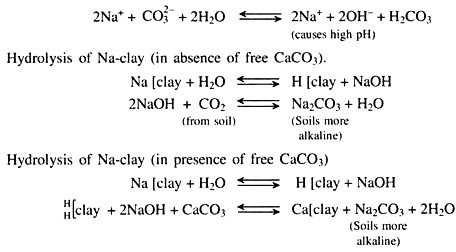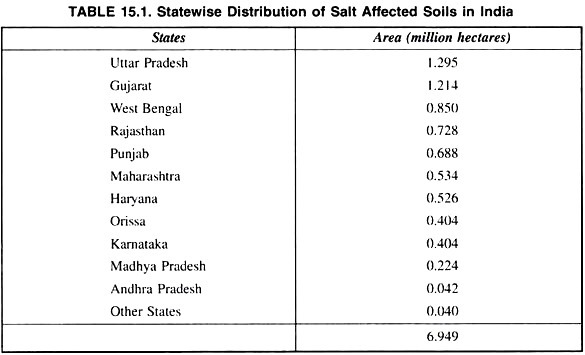ADVERTISEMENTS:
After reading this article you will learn about:- 1. Definition of Saline-Alkali (Sodic) Soils 2. Classification of Saline-Alkali (Sodic) Soils 3. Chemical Reactions 4. Distribution 5. Appraisal.
Definition of Saline-Alkali (Sodic) Soils:
Saline (Solonchak, Russian Term) Soil:
Saline soils defined as a soil having a conductivity of the saturation extract greater than 4 dSm-1 (0.4 Sm-1 or 4 mmhos cm-1) and an exchangeable sodium percentage (ESP) less than 15. The pH is usually less than 8.5. Formerly these soils were called white alkali soils because of surface crust of white salts.
ADVERTISEMENTS:
Alkali (Non-Saline Alkali or Sodic or Solonetz, a Russian Term) Soil:
Alkali or sodic soil is defined as a soil having a conductivity of the saturation extract less than 4 dSm-1 (0.4 Sm-1 or 4 mmhos cm-1) and an exchangeable sodium percentage (ESP) greater than 15. The pH is usually between 8.5-10.0. Formerly these soils were called black alkali soils and the soil so formed is called solod, soloth or degraded alkali or sodic soil.
Black Alkali Soil:
Sodic or alkali soils were formerly called black alkali soils. Due to high pH and the dominance of sodium (Na+) ions in alkali or sodic soils, part of the soil organic matter dissolves and comes into the soil solution.
ADVERTISEMENTS:
Extracts of such soils have a characteristic dark brown or black colour. The dissolved organic matter in the soil solution becomes deposited as a thin film on the soil surface. The prevalence of such black stains in such soils is called “Black alkali” soils.
Classification of Saline-Alkali (Sodic) Soils:
‘The position of saline-alkali (sodic) soils in the new comprehensive classification system (proposed by United States Department of Agriculture, 1960) has been placed with the fourth (4th) order, Aridisol because of their close association with arid and semi-arid climatic conditions. The alkali soils also fall under the fifth (5th) order Mollisol.
The different Orders, Sub-orders and Great Soil-groups for the saline-alkali soils of India are as follows:
1. Orthids:
ADVERTISEMENTS:
The soils of this sub-order are dry for most of the time and have no argillic or natric horizon. All saline soils can be tentatively classified under this sub-order.
2. Salorthids:
This Great Soil Groups, Salorthids have been distinguished under the sub-order, orthids. It has salic horizon at a depth less than 50 cm. It has also been found that there is salt efflorescence at the surface soil. All fluffy solonchak soils are included in this Great Soil Groups.
ADVERTISEMENTS:
3. Argids:
Soils of this sub-order have an argillic or natrichoriozn. Soils are dry most of the time. These soils also have a calcic or salic horizon or a duripan. All non-saline alkali and solonetz soils are included in this sub-order. There are two distinguished Great Soil Groups (Natrargids and Nadurargids) under this sub-order.
4. Natrargids:
Soils of this Great Soil Groups have an Ochricepipedon and an argillic (clay) horizon. Natric (Sodium accumulation) horizon is also found at some horizons of soil profile. They have no duripan. They may or may not be calcareous.
ADVERTISEMENTS:
5. Nadurargids:
Soils of this Great Soil Groups have also an ochricepipedon, natric horizon and a duripan. The duripan is cemented with CaCO3. The entire solonetz group of soils is included in this Great Soil Groups. Various workers have also proposed more sub-groups viz. salic, natric and natraquic to classify saline-alkali soils.
Such considerations in classification of salt affected soils of India will be of greater value for land use planning and management practices.
Chemical Reactions Resulting High pH in Alkali or Sodic Soils:
Since alkali or sodic soils contain adequate amount of sodium carbonate (Na2CO3), so the hydrolysis of Na2CO3 results high pH.
Saline-Alkali Soil:
Saline-alkali soil is defined as a soil having a conductivity of the saturation extract greater than 4 dSm-1 (0.4 Sm-1 or 4 mmhos cm-1) and an exchangeable sodium percentage (ESP) greater than 15. The pH is variable and usually above 8.5 depending on the relative amounts of exchangeable sodium and soluble salts.
When soils dominated by exchangeable sodium, the pH will be more than 8.5 and when soils dominated by soluble salts, the pH will be less than 8.5.
Degraded Alkali or Sodic Soil:
If the extensive leaching of a saline-sodic soil occurs in the absence of any source of calcium or magnesium, part of the exchangeable sodium is gradually replaced by hydrogen. The resulting soil may be slightly acid with unstable structure. Such a soil is called degraded alkali or sodic soil.
Sodium carbonate (Na2CO3) dissolves humus and is deposited in the lower layer. The lower layer thus acquires a black colour. At the same time H-clay formed in this way does not remain stable. The process of break-down of H-clay under alkaline condition is known as solodisation.
Distribution of Saline-Alkali (Sodic) Soils:
It has been estimated that about 7 million hectares of land in India are salt affected i.e. saline and alkali soils. State wise distribution of salt affected soils in India is given in Table 15.1.
Out of total cropped area in West Bengal (7.40 million hectares), about 0.85 million hectares of land are salt affected. These soils are found in coastal regions of West Bengal. The southern portions of 24 Parganas (south), Howrah and Midnapore districts constitute the coastal region of the state which includes numerous islands.
Deposits from tidal currents in the estuarine region resulted into formation of cluster of islands. The vast forests known as the Sundarbans lie in this region covering an area of 4300 sq km. The coastal soils are alluvial and partially saline with sporadic patches of saline-alkali, non-saline alkali and degraded alkali soils.
The soil pH varies from 7.0-8.5. In patches lower pH even below 5.0 are also recorded which suggest the presence of acid sulphate soils as well as muck soils with deep black colour. Due to predominance of magnesium (Mg2+) the soils become hard when dry and get deflocculated when wet leading to impeded drainage condition.
Appraisal of Saline and Sodic Soils:
1. Saline Soil:
Different criteria are employed for characterizing soil salinity and those are given below:
(i) Soluble Salt Concentration in the Soil Solution:
In saline soil the soluble salt concentration in the soil solution is very high and as a result the osmotic pressure of the soil solution is also very high. As a result of which the plant growth is affected due to wilting and nutrient deficiency. Salt content more than 0.1 per cent is injurious to plant growth.
(ii) Osmotic Pressure (O.P.):
Osmotic pressure of the soil solution is closely related to the rate of water uptake and the growth of plants in saline soils.
The osmotic pressure (O.P.) of soil solutions is usually calculated from the freezing point depressions as follows:
Osmotic Pressure (O.P.) = 12.06 ∆T – 0.021 ∆T2
where∆T = depression of freezing point in soil solution
It should be assessed of field capacity soil moisture regimes.
Besides the relation between OP and electrical conductivity (EC) for salt mixtures found in saline soils, is given below:
OP (in atmospheres or bars) = 0.36 × EC
where EC expressed as dSm-1.
(iii) Electrical Conductivity (EC) of the Soil Saturation Extract:
Measurement of EC of the soil saturation extract is also essential for the assessment of the saline soil for the plant growth and is expressed as dSm-1 (formerly mmhos cm-1).
EC values (dSm-1)
<2 — Salinity effects mostly negligible
2 – 4— Yields of very sensitive crops may be restricted
4 – 8— Yields of many crops restricted
8 – 16 — Only tolerant crops yields satisfactorily
>16 — Only a few very tolerant crops yield satisfactorily
(iv) Concentration of Water Soluble Boron:
The determination of water soluble boron concentration is also an another criteria for characterisation of saline soils.
The critical limits of boron concentration for the plant growth are given below:
Boron concentration (ppm)
< 0.7 – Crops can grow (safe)
0.7 – 1.5 — Marginal
>1.5 — Unsafe
(v) Soil Texture:
A sandy soil with 0.1 per cent salt would be saline enough to injure the growth of common crops, while a clayey soil with the same amount of salt may be just a normal soil in which the yields of even sensitive crops would not be affected.
The U.S. Salinity Laboratory (USDA, Hand book, 60) has developed the concept of saturation percentage (SP), as a characteristic property of each soil, which depends on the texture of the soil and the electrical conductivity of saturation extract (EC) as a means of salinity appraisal.
The recent technique developed by the U.S. Salinity Laboratory is to use pressure membrane apparatus for extracting soil solution at any desired level in the entire field moisture range.
2. Alkali Soil:
There are various methods employed for its approval that are as follows:
(i) Development of a quick and accurate method for determining exchangeable sodium in saline-sodic and sodic soils, to serve as a guide for reliable appraisal of the alkali conditions, has always been a problem. A direct determination of exchangeable sodium in saline-alkali soils is best with many difficulties because of the presence of sodium salts in equilibrium with exchangeable sodium in the soil-water system.
Exchangeable sodium (Approximately) = Total sodium (exchangeable + soluble) – Soluble sodium
Sometimes soil pH also gives an indication of soil alkalinity indirectly. An increase in pH reading of 1.0 or more, with change in the moisture content, from a low to high value, has itself been found useful in some area for detecting alkali conditions in soils. It is generally found that the higher the ESP, the higher is the soil pH.
(ii) Sodium Adsorption Ratio (SAR):
The U.S. Salinity Laboratory developed the concept of Sodium Adsorption Ratio (SAR) to define the equilibrium between soluble and exchangeable cations as follows:
The value of SAR can be used for the determination of Exchangeable Sodium Percentage (ESP) of the saturation extract by using the following formula:
ESP = 100(-0.0126 + 0.01475 SAR)/1 +(-0.0126+ 0.01475 SAR)
Sometimes the following regression equation is used for the appraisal of alkali soil by determining the value of ESP from the value of SAR.
Y = 0.0673 + 0.035 X
where Y indicates ESP and
X indicates SAR
Soils having SAR value greater than 13 are considered as alkali or sodic soil.






Comments are closed.